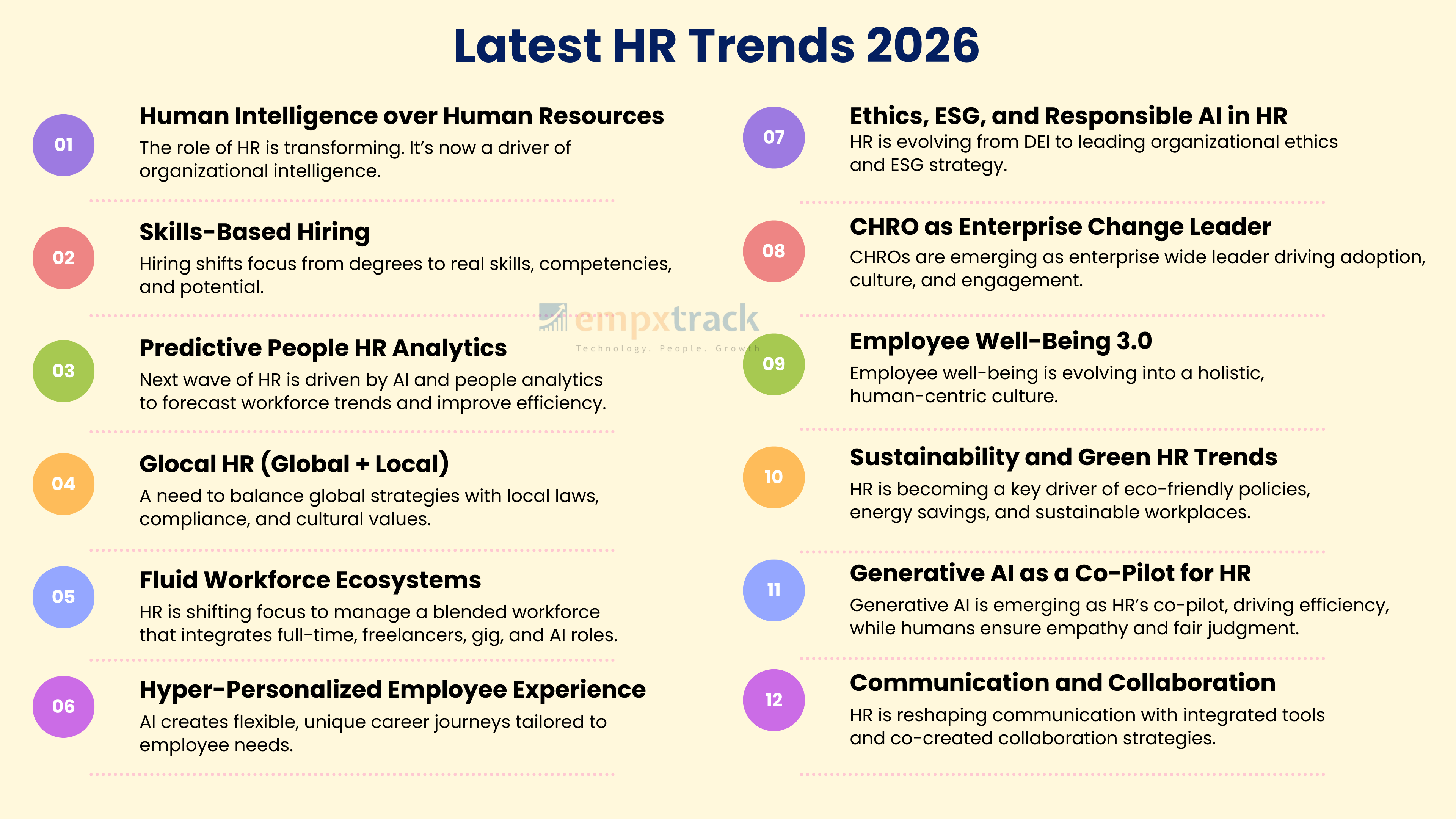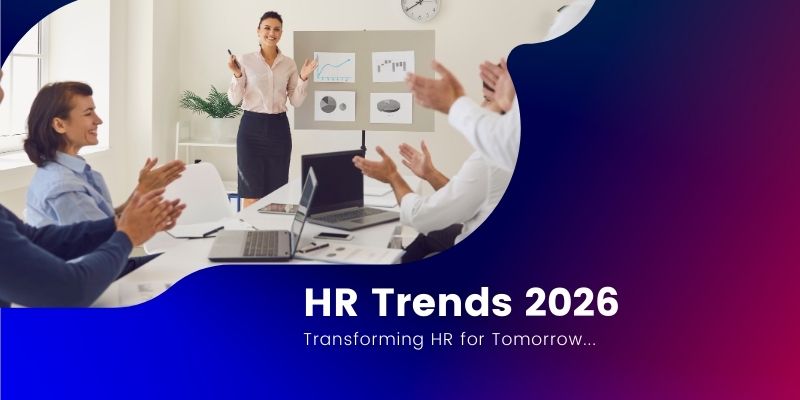Is your HR team ready for 2026?
Human resource function has undergone a significant transformation. The recent HR trends 2026 highlight a major shift in focus from administrative tasks to strategic functions. This transformation, driven by HR automation, is actively shaping business success and workforce dynamics. HR’s role is now instrumental in building agile organizations and improving employee experience.
Key Summary
- » HR will focus on human adaptability, continuous reskilling, & skills-based hiring.
- » Predictive analytics & AI will forecast turnover, engagement, & productivity trends.
- » HR leaders will balance global goals with local compliance, manage hybrid teams, freelancers and encourage green HRM.
- » AI, behavioral science, & ESG alignment will drive transparency & trust in modern workplaces.
- » CHROs are emerging as enterprise change leaders.
- » Generative AI will boost efficiency, while holistic, human-centric well-being ensures connection & belonging.
The speed of change is being accelerated by digital innovation and workforce’s expectations. Modern HR is now using the latest technology to make choices that are truly data-driven. They are managing the increasingly complicated world of international talent acquisition, retention, and compliance with the aid of these technologies.
In this blog, we will look at the recent HR trends 2026 that will shape the future workplace culture.
Table of Contents
- 1. Latest HR Trends 2026: How Workplaces Will Transform?
- Human Intelligence over Human Resources
- Skills-Based Hiring and Reskilling
- Predictive People HR Analytics
- Glocal HR (Global + Local)
- Fluid Workforce Ecosystems
- Hyper-Personalized Employee Experience
- Ethics, ESG, and Responsible AI in HR
- CHRO as Enterprise Change Leader
- Employee Well-Being 3.0
- Sustainability and Green HR Trends
- Generative AI as a Co-Pilot for HR
- Communication and Collaboration
- 2. Future of HR in 2030
- 3. Frequently Asked Questions
Latest HR Trends 2026: How Workplaces Will Transform?
1. Human Intelligence over Human Resources
By human intelligence, it usually refers to the human ability to learn from one’s experience and adapt and use the knowledge to control the environment.
Human intelligence provides a fresh perspective on how work is actually done rather than depending on strict, top-down evaluations or transactional data.
Human resource professionals are now the driver of organizational intelligence. By 2026, HR will shift its main focus to how people think, learn, adapt, and innovate.
2. Skills-Based Hiring and Reskilling
By 2026, continuous learning, reskilling and upskilling will also become the core business priority. Companies will prioritize skills over degrees and adopt skills-based hiring. This will enable them to tap into a broader talent pool and make sure that new hires are genuinely qualified, thus reducing productivity turnaround time.
According to Forbes, employers report that skills-based hiring leads to better hiring decisions, with 90% stating they make better hires based on skills over degrees.
3. Predictive People HR Analytics
The next wave of HR will increasingly rely more on people analytics platforms for modern business practices, such as advanced dashboards and reporting tools. By leveraging HR technology trends and human capital management trends, data-driven decisions will help in enhancing operational efficiency across sectors and improve workforce forecasting capabilities.
So, what does this mean to HR leaders? They can predict global trends like employee engagement or employee leave trends with the help of statistical models and machine learning algorithms. These will help them identify patterns such as turnover or employee productivity patterns, and aid in predicting future demands.
According to MarketsandMarkets, the global market is expected to reach USD 28.1 billion by the end of 2026, growing at a CAGR of 21.7%.
4. Glocal HR (Global + Local)
As 2026 is approaching, companies and global leaders working across APAC, EU, and the US, will need to balance global strategy with local compliance requirements, labor laws, and cultural norms.
What does it mean? This means HR leaders must now invest in compliance intelligence and culture fluency to ensure policies are legally sound and socially relevant in every market. This further refers to adapting employee benefits, working hours to local laws and regulations, and embedding cultural awareness into HR strategies. Companies will design performance reviews, and communication protocols that respect local customs while still aligning with global goals.
5. Fluid Workforce Ecosystems
The workplace is no longer defined by a single model as employees either work remotely, remain on-site, or work in a hybrid model. This reflects the hybrid workplace trends that are already shaping modern workplaces. Moreover, companies are embracing a fluid workforce, one that seamlessly blends full-time staff, freelancers, gig workers, and AI-assisted teams.
Companies like Novartis and Cisco employ a significant number of contingent workers alongside their full-time staff, highlighting the growing importance of a blended workforce in today’s business world.
HR leaders must build strategies that reflect emerging global HR trends and effectively manage and engage talent across multiple contract types. Moreover, performance systems must adapt to the varying types of contracts.

6. Hyper-Personalized Employee Experience
In the future, HR will increasingly use AI, behavioral science, and digital nudges to design career journeys, flexible and customized to each employee. The personalization will work through employee feedback and surveys, thus creating unique experiences based on generational differences, role types, or career stages.
Employees who perceive their experience as personalized are significantly more engaged. They are 4.6 times more likely to perform at their best when they feel heard and valued.
7. Ethics, ESG, and Responsible AI in HR
The HR function is moving beyond traditional Diversity, Equity, and Inclusion or DEI in HR programs to overseeing ethics and governance. As workplaces become more digital, companies face new scrutiny around labor rights, data privacy, sustainability, and responsible use of technology.
What’s Different in 2026
» HR will align with sustainability leaders to ensure ethical labor practices and socially responsible policies, thus uniting HR strategy with ESG priorities.
» There will be a need to set rules for transparency, bias reduction, and ethical decision-making. Also, privacy and fairness need to be ensured while still leveraging analytics to improve engagement and productivity.
» HR leaders will also need to communicate openly with employees about how their data and AI tools are used, thus building strong trust in modern HR systems and decisions.
8. CHRO as Enterprise Change Leader
CHROs are becoming leaders of change, evolving beyond simply having a “seat at the table”. Their expertise will continue to help retain top talent, unify teams, and sustain productivity during transitions. CHROs are also playing a pivotal role in reinforcing organizational culture, upholding core values, and driving employee engagement strategies.
Their role also includes addressing retirement risks, fostering multigenerational workforce cohesion, and leveraging technology for fair, unbiased performance evaluations.
9. Employee Well-Being 3.0
Earlier in 2024-25, the focus of employee well-being was on mental health and flexible work. Now, in 2026, the focus will move beyond basic physical and mental health programs toward holistic employee well-being trends.
Teams are now spread across time zones, contract types (full-time, freelance, gig workers), and even human + AI collaborations. This creates complexity in keeping everyone aligned and engaged, directly linking to the employee engagement trend.
Now, well-being is about creating a human-centric culture where everyone feels connected, valued, and supported. It does not matter how or where they work. Employees feel more engaged and productive if they feel that they are digitally and socially connected.
10. Sustainability and Green HR Trends
Sustainability will no longer be the sole responsibility of CSR or ESG. In 2026, however, HR will play a role in driving sustainable workplaces and encouraging green HRM. This includes encouraging energy efficiency, reducing paper use, and offering hybrid/remote options to cut commuting emissions.
They will also collaborate with sustainability teams to integrate carbon reduction targets into workforce strategies. For instance, encouraging virtual meetings instead of unnecessary flights, or incentivizing employees who adopt greener commuting methods.
11. Generative AI as a Co-Pilot for HR
In 2026, Generative AI in human resources is going to act as the true co-pilot for HR leaders. This will move beyond basic chatbots that answer FAQs.
Generative AI will help companies improve hiring and promote bias-free evaluations. In addition, it will play an important role in workforce planning and recommending training programs.
Although Generative AI as a co-pilot will make HR faster, smarter, and more strategic, it cannot replace the human touch. Ultimately, its true value emerges when combined with human judgment and emotional intelligence.

The winning formula in 2026 will be AI for efficiency and humans for empathy. Hence, creating HR processes that are both data-driven and deeply human.
12. Communication and Collaboration
Effective communication is going to become the backbone of workplace productivity and culture. Organizations will invest in integrated communication suites that combine chat, video, project management, and knowledge-sharing instead of juggling numerous platforms. This will ensure that all employees receive consistent and accessible information.
HR will also adopt a researcher’s mindset, focusing on gathering feedback, analyzing data, and testing approaches. As a result, they can better understand which communication and collaboration strategies actually work. Subsequently, they will co-create workplace strategies with employees at all levels.
Future of HR in 2030
Organizations are expected to use AI extensively in 2030 for tasks such as employee onboarding, candidate screening, and predictive people analytics for talent management trends, and many more.
Automation will handle routine tasks, allowing HR personnel to focus more on strategic and human-centred aspects of their work. Employees will also need to understand automation and artificial intelligence if they do not want to run the risk of being replaced.
Human resources trends in 2030 will also be characterized by data-driven decision-making processes. It will focus on employee experience and commitment to create flexible and inclusive workplaces.
Organizations will be able to detect possible issues and take proactive steps to resolve them with the use of predictive analytics. This will make the HR department more responsive and agile. In order to successfully traverse the changing landscape, HR professionals will need to embrace these recent HR trends 2026 and adopt new HR leadership skills and strategies.
Frequently Asked Questions
Q1. | What are the top HR trends for 2026? |
| Ans. | The top HR trends for 2026 are: ● Human intelligence over human resources ● Skill-based hiring ● Generative AI and Predictive Analytics ● Glocal HR ● Fluid workforce ecosystems ● Employee well-being ● Prioritizing employee experience ● Effective communication ● Continuous learning ● Sustainability and green HR ● Role of CHROs ● Ethics in HR |
Q2. | Why are HR trends important? |
| Ans. | Current HR trends are important because they help businesses stay competitive by enhancing employee engagement, boosting performance outcomes, and matching people strategies with changing business objectives. |
Q3. | How will AI change HR in 2026? |
| Ans. | AI will transform human resources in 2026 by automating repetitive operations, forecasting workforce needs, personalizing employee experiences, and fostering continuous learning. Moreover, HR’s main issue will be striking a balance between AI’s efficiency and human empathy and ethical governance. |
Q4. | What role will employee experience play in 2026? |
| Ans. | Ensuring a great employee experience will become a crucial differentiator in talent acquisition and retention as remote work and global workforce grow in popularity. Businesses that put employee experience first in 2026 are probably going to subsequently see greater business results overall, higher retention rates, and stronger morale. |
Q5. | What skills will HR professionals need in 2026? |
| Ans. | In 2026, HR professionals will need a blend of strategic, digital, and human skills. Key areas include: ● Digital literacy & AI fluency ● Data-driven decision making ● Emotional intelligence & empathy ● Cross-cultural fluency ● Ensuring fair AI use, data privacy, and ● Responsible workplace HR best practices |
Q6. | Will hybrid work still be relevant in 2026? |
| Ans. | Yes, hybrid work trends will still be relevant in 2026. |
Q7. | How can companies prepare for upcoming HR trends? |
| Ans. | By investing in digital tools and artificial intelligence (AI), and creating inclusive and flexible policies that support diverse workforces, businesses can prepare for the evolving demands of HR. Additionally, placing a high priority on ongoing learning and reskilling to stay up to date with emerging skills, businesses can get ready for future HR leadership trends. Companies can prepare for recent trends in human resource management by also encouraging holistic well-being, and incorporating sustainability and ethics into HR procedures. |
Q8. | What role will employee experience play in 2026? |
| Ans. | Managing changing remote and hybrid work models, filling the skills gap through training and AI adoption, and retaining top digital talent are some of the challenges. Besides these, promoting employee mental health and well-being in the face of economic pressures and workforce uncertainty are other challenges that HR leaders will face in 2026. |
Q9. | How will people analytics shape decision-making in HR? |
| Ans. | People analytics in HR will improve hiring, talent management, and employee development, shaping the future of work. This will be done by replacing gut feeling with objective, and data-driven decision-making. |
Q10. | What will the future of HR look like in 2030? |
| Ans. | The future of HR in 2030 will be more data-driven and AI-enhanced. Human resource departments will emphasize more on ethical workforce management, ongoing employee skill development, and customized employee experiences. In order to promote culture, engagement, and organizational resilience, HR will serve as a strategic change partner by striking a balance between technology and human empathy. |




This is an amazing article with all the updated and relevant trends for 2026. HR professionals will greatly benefit from these and be prepared for the upcoming transformation. Thanks for sharing them in such a clear and precise manner.
Thank you! We appreciate your thoughtful feedback.
This article provides an insightful overview of the evolving HR landscape as we approach 2026. The emphasis on technological integration, skills development, and workforce flexibility demonstrates a forward-thinking approach that will empower both employees and employers. It’s especially encouraging to see a strong focus on employee well-being, ethical leadership, and sustainability. These trends are not only shaping the future of work, but also reinforcing the importance of a people-centric culture in modern organizations
Thank you! We appreciate your thoughtful feedback.
This HR trends 2026 blog offers a clear and forward-looking perspective on how HR is evolving to meet future workplace challenges. The insights are well-structured and provide valuable guidance for organizations navigating transformation. A must-read for HR professionals preparing for the future of work.
Thank you. We’re glad you found the content useful.
Really insightful breakdown! Excited to see how the recent HR trends 2026, especially predictive analytics and hyper-personalized employee experiences, will reshape workplace culture.
We’re glad you’re finding the content useful.